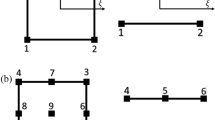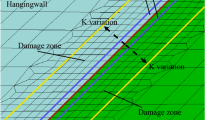Abstract
This article illustrates the use of the modified ‘q-based’ GEM for complex geological problems in anisotropic media involving faults/fractures, by adopting various values of the permeability for both the faults/fractures and the media. The bulk permeabilities are compared and illustrated for different cases. Examples based on generating randomly positioned faults for which the number of faults can vary, but the sum of their lengths is fixed, are investigated. Situations are presented for a number of different total fault lengths and for various physical properties of the faults within a fixed total fault length. For some of the cases, particle traces are shown to better illustrate the behaviour of the flow.
Similar content being viewed by others
References
Barenblatt G., Zheltov Y., Kochina I.: Basic concepts in the theory of seepage of homogeneous fluids in fissurized rocks. J. Appl. Math. Mech. 24(5), 1286–1303 (1983)
Chang Y.P., Kang C.S., Chen D.J.: The use of fundamental Green’s functions for the solution of heat conduction in anisotropic media. Int. J. Heat Mass Transf. 16, 1905–1918 (1973)
Fisher Q.J., Knipe R.J.: The permeability of faults within siliciclastic petroleum reservoirs of the North Sea and Norwegian Continental Shelf. Marine Pet. Geol. 18(10), 1063–1081 (2001). doi:10.1016/S0264-8172(01)00042-3
Ghorayeb K., Firoozabadi A.: Numerical study of natural convection and diffusion in fractured porous media. SPE 5(1), 12–20 (2000)
Harris S.D., McAllister E., Knipe R.J., Odling N.E.: Predicting the three-dimensional population characteristics of fault zones: a study using stochastic models. J. Struct. Geol. 25, 1281–1299 (2003)
Harris, S.D., Fisher, Q.J., Karimi-Fard, M., Vaszi, A.Z., Wu, K.: Modelling the effects of faults and fractures on fluid flow in petroleum reservoirs. In: Ingham, D.B., Pop, I. (eds.) Transport Phenomena in Porous Media, vol. III, Ch. 17, pp. 441–476. Elsevier, Oxford (2005)
Hoteit H., Firoozabadi A.: An efficient numerical model for incompressible two-phase flow in fractured media. Adv. Water Res. 31, 891–905 (2008)
Juanes R., Samper J., Molinero J.: A general and efficient formulation of fractures and boundary conditions in the finite element method. Int. J. Numer. Methods Eng. 54, 1751–1774 (2002)
Lorinczi P., Harris S.D., Elliott L.: Modelling of highly-heterogeneous media using a flux-vector based Green element method. Eng. Anal. Bound. Elem. 30, 818–833 (2006)
Lorinczi, P., Harris, S.D., Elliott, L.: Modified flux-vector based GEM for problems in steady-state anisotropic media. Eng. Anal. Bound. Elem. (2008). doi:10.1016/j.enganabound.2008.06.004
Monteagudo, J.E.P., Firoozabadi, A.: Control-volume method for numerical simulation of two-phase immiscible flow in 2D and 3D discrete-fracture media. Water Resour Res, 40, W07405 (2004) doi:10.1029/2003WR002996
Noorishad J., Mehran M.: An upstream finite element method for solution of transient transport equation in fractured porous media. Water Resour. Res. 18(3), 588–596 (1982)
Onyejekwe O.O.: A boundary element-finite element equation solution to flow in heterogeneous porous media. Transp Porous Media 31, 293–312 (1998)
Pecher R., Harris S.D., Knipe R.J., Elliott L., Ingham D.B.: New formulation of the Green element method to maintain its second-order accuracy in 2D/3D. Eng. Anal. Bound. Elem. 25, 211–219 (2001)
Shewchuk, J.R.: An introduction to the conjugate gradient method without the agonizing pain. Tech. Rep. CMU-CS-94-125, School of Computer Science, Carnegie Mellon University, Pittsburgh, PA 15213 (1994)
Symm, G.T., Pitfield, R.A.: Solutions of the Laplace’s equation in two dimensions. NPL Report NAC 44, (1974)
Taigbenu, A.E.: A more efficient implementation of the boundary element theory. Proceedings of the Fifth International Conference on Boundary Element Technology (BETECH 90), pp. 355–366. Newark, Delaware (1990)
Taigbenu A.E.: The Green Element Method, vol. 38. Kluwer Academic Publishers, Boston (1999)
Taigbenu A.E., Onyejekwe O.O.: Green’s function-based integral approaches to linear transient boundary-value problems and their stability characteristics (I). Appl. Math. Model 22, 687–702 (1998)
Taigbenu A.E., Onyejekwe O.O.: Green’s function-based integral approaches to nonlinear transient boundary-value problems (II). Appl. Math. Model 23, 241–253 (1999)
Taigbenu A.E., Onyejekwe O.O.: A flux-correct Green element model of quasi three-dimensional multiaquifer flow. Water Resour. Res. 26, 675–684 (2000)
Author information
Authors and Affiliations
Corresponding author
Rights and permissions
About this article
Cite this article
Lorinczi, P., Harris, S.D. & Elliott, L. Influence of Media Properties on Fluid Flow in Faulted and Fractured Anisotropic Media: A Study Using a Modified Flux-Vector-Based Green Element Method. Transp Porous Med 80, 469–498 (2009). https://doi.org/10.1007/s11242-009-9376-3
Received:
Accepted:
Published:
Issue Date:
DOI: https://doi.org/10.1007/s11242-009-9376-3




